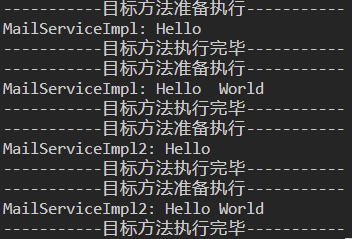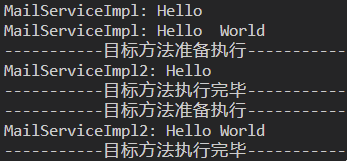面向切面编程(Aspect Oriented Programming, AOP)的概念非常简单,它把系统的一些非业务功能(如日志记录、性能监控、事务管理等)从业务代码中剥离出来定义成切面,再把这些切面作为对业务代码的增强。降低了非业务功能对业务代码的侵入,进一步降低了两者的耦合程度。
如按照图1的普通做法,在方法1~方法3中,都添加了权限验证和日志记录的非业务功能。但这些非业务功能在不同位置的做法其实是一样的,有重复嫌疑;另外,这些非业务功能代码遍布整个业务代码,与核心业务代码的联系过于紧密。

图2采用AOP编程的方法,将权限验证和日志记录的功能单独拎出来,做成两个切面,然后通过框架机制将其指定为原代码的增强代码。这样的话,从代码实现上显得更加清晰。

Java的Spring框架对AOP有非常棒的支持,而且使用起来非常流畅;.NET框架也有相应的AOP库可供使用,但从使用体验上远不及Spring框架。
Spring的AOP
使用流程
1
2
3
4
| <dependency>
<groupId>org.springframework.boot</groupId>
<artifactId>spring-boot-starter-aop</artifactId>
</dependency>
|
- 自定义一个注解,用于指明需要增强的目标方法,也可以通过方法路径来指定
1
2
3
4
5
6
7
8
9
10
11
12
13
| package com.example.testdi;
import java.lang.annotation.Documented;
import java.lang.annotation.ElementType;
import java.lang.annotation.Retention;
import java.lang.annotation.RetentionPolicy;
import java.lang.annotation.Target;
@Target(ElementType.METHOD)
@Retention(RetentionPolicy.RUNTIME)
@Documented
public @interface LHAnnotation {
}
|
- 核心:新建一个切面类,用
@Aspect指定,定义切面功能逻辑,且必须将其指定为Bean
1
2
3
4
5
6
7
8
9
10
11
12
13
14
15
16
17
18
19
20
21
| package com.example.testdi;
import org.aspectj.lang.ProceedingJoinPoint;
import org.aspectj.lang.annotation.Around;
import org.aspectj.lang.annotation.Aspect;
import org.aspectj.lang.annotation.Pointcut;
import org.springframework.stereotype.Component;
@Aspect
@Component
public class LoggingAspect {
@Pointcut("@annotation(com.example.testdi.LHAnnotation)")
private void AOPTest() {}
@Around("AOPTest()")
public void AOPTestMethod1(ProceedingJoinPoint joinPoint) throws Throwable {
System.out.println("-----------目标方法准备执行-----------");
joinPoint.proceed();
System.out.println("-----------目标方法执行完毕-----------");
}
}
|
- 指定对
MailServiceImpl的Send()方法进行增强
1
2
3
4
5
6
7
8
9
10
11
| package com.example.testdi;
import org.springframework.stereotype.Component;
@Component
public class MailServiceImpl {
@LHAnnotation
public void Send(String title, String to, String body) {
System.out.println("发邮件了: " + title +","+ to +","+ body);
}
}
|
- 需要为主类指定
@EnableAspectJAutoProxy,表明开启切面功能
1
2
3
4
5
6
7
8
9
10
11
12
13
14
15
16
17
18
| package com.example.testdi;
import org.springframework.context.annotation.AnnotationConfigApplicationContext;
import org.springframework.context.annotation.ComponentScan;
import org.springframework.context.annotation.Configuration;
import org.springframework.context.annotation.EnableAspectJAutoProxy;
@Configuration
@ComponentScan(basePackages = "com.example.testdi")
@EnableAspectJAutoProxy
public class DemoApplication {
public static void main(String[] args) {
AnnotationConfigApplicationContext context = new AnnotationConfigApplicationContext(DemoApplication.class);
var greeting = context.getBean(MailServiceImpl.class);
greeting.Send("第一封邮件", "LiRuohan", "你好,依赖注入!");
context.close();
}
}
|
切面定义
-
定义切点:目的是告诉程序要对哪些方法进行增强
(1)注解方式:这种比较简单,上面的例子就是
(2)表达式方法:适合批量指定,非常灵活

下面做个小实验,定义两个邮件发送服务类,看不同的表达式会映射到哪些方法:
1
2
3
4
5
6
7
8
9
10
11
12
13
14
15
16
17
18
19
20
21
22
23
24
25
26
27
28
29
| @Component
public class MailServiceImpl {
public void Send(String text1) {
System.out.println("MailServiceImpl: "+text1);
}
public void Send2(String text1, String text2) {
System.out.println("MailServiceImpl: " +text1 + "\t" + text2);
}
}
@Component
public class MailServiceImpl2 {
public void Send(String text1) {
System.out.println("MailServiceImpl2: " + text1);
}
public void Send2(String text1, String text2) {
System.out.println("MailServiceImpl2: " + text1 + "\t" + text2);
}
}
public static void main(String[] args) {
AnnotationConfigApplicationContext context = new AnnotationConfigApplicationContext(TestaopApplication.class);
var greeting = context.getBean(MailServiceImpl.class);
greeting.Send("Hello");
greeting.Send2("Hello","World");
var greeting2 = context.getBean(MailServiceImpl2.class);
greeting2.Send("Hello");
greeting2.Send2("Hello","World");
context.close();
}
|
下面表达式会映射到所有的Send方法:
1
2
| @Pointcut("execution (* com.example.testaop.*.*(..))")
private void AOPTest() {}
|

下面表达式只会映射到MailServiceImpl2的两个Send方法:
1
2
| @Pointcut("execution (* com.example.testaop.MailServiceImpl2.*(..))")
private void AOPTest() {}
|

下面表达式只会映射到MailServiceImpl2的Send2方法:
1
2
| @Pointcut("execution (* com.example.testaop.MailServiceImpl2.Send2(..))")
private void AOPTest() {}
|

下面表达式只会映射到两个类的Send方法(仅一个参数):
1
2
| @Pointcut("execution (* com.example.testaop.*.*(java.lang.String))")
private void AOPTest() {}
|

-
定义通知
@Before:方法执行之前@After:方法执行之后@Around:同时定义方法执行之前和执行之后的逻辑@AfterReturning:在目标方法成功执行,不抛出异常后执行,与@AfterThrowing互补,与@After有别@AfterThrowing:抛出异常后的执行逻辑
-
应用多个切面
可使用@Order()为切面类指定序号,序号小者先执行。
.NET的AOP
目前来看,.NET中免费且与Spring AOP用法较为接近的库是AspectInjector,其用法非常简单,示例如下:
1
2
3
4
5
6
7
8
9
10
11
12
13
14
15
16
17
18
19
20
21
22
23
24
25
26
| [Aspect(Scope.Global)]
[Injection(typeof(LogCall))]
public class LogCall : Attribute {
[Advice(Kind.Around)]
public Object Injection(
[Argument(Source.Type)] Type type,
[Argument(Source.Name)] string name,
[Argument(Source.Target)] Func<object[], object> target,
[Argument(Source.Arguments)] object[] arg) {
Console.WriteLine($"Calling '{name}' method...");
var res = target(arg);
Console.WriteLine($"Finished calling '{name}' method...");
return res;
}
}
|
1
2
3
4
5
6
7
| public class LogCallTest {
[LogCall]
public void Calculate(string text) {
Console.WriteLine(text);
Console.WriteLine("Calculated");
}
}
|
1
2
3
4
5
| static void Main(string[] args) {
LogCallTest test = new LogCallTest();
test.Calculate("李浩测试");
Console.ReadKey();
}
|

总结
学习AOP技术,我认为对这种编程思想的理解更为重要,依托具体框架掌握其使用流程可以帮助我们更直观理解。
AOP技术基于代理模式实现,由框架或库为开发者创建代理类,开发者只需要为框架或库指明增强对象和增强行为即可。
在编程开发中,很多看似高大上的技术,其实都依赖某些巧妙的设计模式实现,设计模式的重要性可见一斑!





